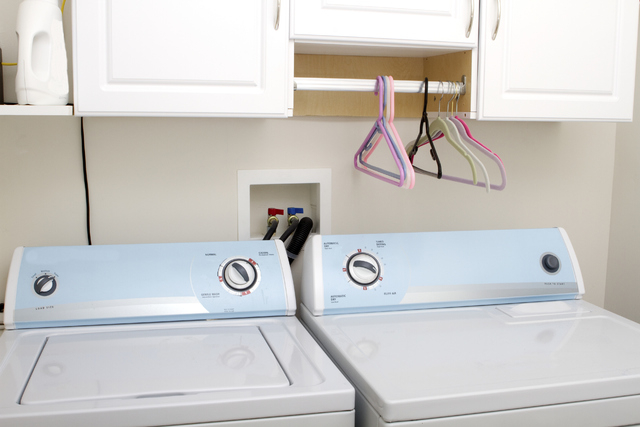Installing washer and dryer is a matter of connections
Q: We recently moved into a new house and need to install a washer and dryer. We have a gas dryer and there is a pipe with a cap on it coming out of the wall. Where do I start?
A: Installing the washing machine is a matter of connecting the water supply and the drain. For the dryer, you’ll make the gas connection and connect the exhaust.
Let’s start with the washer. I recommend that you buy steel-braided washing machine hoses. They cost about $12 each (you’ll need two), but typically carry a 10-year warranty against leakage.
I know people who, upon returning home from vacation, are greeted by a watery mess because the rubber hoses on their washing machine sprang a leak. Buy the steel-braided hoses and you, as well as your insurance agent, can rest easy. Screw the hot side on the washer to the hot faucet, then do the same for the cold side.
With a new house, you may have to remove the knockout plug on the drain. If so, just drill a big hole in it and pull it out with pliers. Insert the drain hose securely into the drain hole. Turn on the water, plug in the washer, check for leaks and then run the washer through a cycle to make sure it drains properly.
Let’s move on to the dryer. Remember, you’ll be working with natural gas, so no smoking, etc. You’ll need a gas valve (about $10), a length of flexible gas hose and an exhaust hose.
The proper way to connect a gas valve is to turn off the gas at the main and install the valve. When you do this, you’ll need to relight the pilot lights on your gas appliances if they don’t have electronic ignitions.
To remove the cap, you’ll use two pipe wrenches: one to unscrew the cap and the other to hold the pipe still. Take yellow gas tape, wrap the threads three times, then screw the new valve on snugly.
With the gas on, use soapy water to test for leaks. If you see bubbles, you have a leak and will need to give the valve another quarter turn or reseat it. Make sure the valve is in the “off” position.
Connect the flexible gas line to the valve the same way. Use the yellow gas tape and crank it down. Attach the gas line to the dryer the same way, then test the fittings for leaks.
The toughest task is the exhaust hose, which is made of a flexible foil-like material with sleeves on each end. One end attaches to the dryer and the other to the wall vent. I attach the dryer side first. One end fits nicely over the dryer flange and connects with the turn of a screwdriver.
This type of exhaust hose can kink and constrict the flow of exhaust. Ideally, a rigid metal exhaust hose should be used, however, it requires significantly more room, so most people don’t use it.
The wall vent usually gets beat up by the builder, the movers and whoever else fancies a good kick at it. It typically isn’t round anymore, so you may have to get creative. You can try bending it back to its original shape using pliers or a hammer, or you can cut slits in the vent then push each flap slightly inward. Now you should be able to get the collar of the dryer hose over the vent.
I must say, though, you could forgo all this advice and “do” laundry another way. When you wake up in the morning, sift through the pile of clothes on the floor, then pick out a few items and throw them against the wall. Those that don’t stick are good for another wearing.
Mike Klimek is a licensed contractor and owner of Las Vegas Handyman. Questions may be sent by email to: handymanoflasvegas@msn.com. Or, mail to: 4710 W. Dewey Drive, No. 100, Las Vegas, NV 89118. His Web address is www.handymanoflasvegas.com.

















